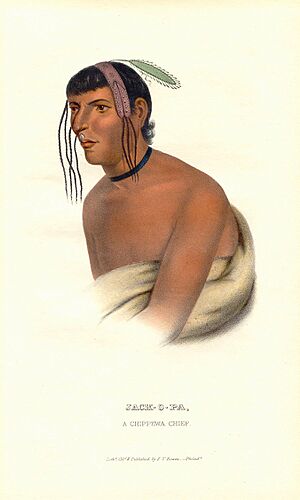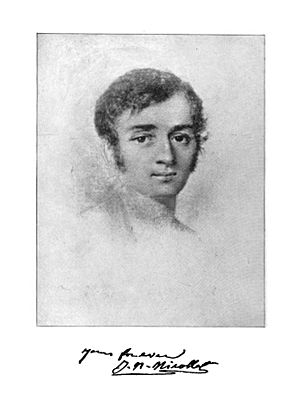Zhaagobe facts for kids
Zhaagobe (born around 1794) was an important leader, or chief, of the St. Croix Ojibwe people. He was also known as Jack-O-Pa or Shagobai. He led the Snake River band of the Ojibwe.
Chief Zhaagobe signed several important agreements, called treaties, with the United States government. These treaties included the 1825 Treaty of Prairie du Chien, the 1826 Treaty of Fond du Lac, the 1837 Treaty of St. Peters, and the 1842 Treaty of La Pointe.
A French mapmaker named Joseph Nicollet had an Ojibwe guide called Chagobay in 1836. Historians are not sure if this guide was the same person as Chief Zhaagobe.
Chief Zhaagobe's picture was painted by Charles Bird King. It is in a book called History of the Indian Tribes of North America. In the book, his name is "Jack-O-Pa – The Six."
Contents
Joseph Nicollet's Ojibwe Guide
An Ojibwe man named Chagobay helped French mapmaker Joseph Nicollet as a guide. This was during Nicollet's trip to the upper Mississippi River in 1836. However, some historians are not sure if this guide was the same person as the Snake River chief, Zhaagobe.
The name "Zhaagobe" is the Ojibwe word for "Six." In his travel notes, Joseph Nicollet called his guide "Chagobay," "Shago-bai," or "Little Six."
In 1836, Chagobay traveled with Nicollet to Leech Lake. Chagobay's ten-year-old son also came along. They started their journey from Saint Anthony Falls on July 29, 1836. Another guide, Brunia, who was half-French, joined them.
On their first day, they saw many Sioux canoes. These canoes were returning from a fight against the Chippewa people. Nicollet learned that the Sioux group came from Bde Maka Ska (which used to be called Lake Calhoun). They also came from the village of Shakopee, near where Shakopee, Minnesota is today.
Chagobay shared details about the upper Mississippi River and its smaller rivers with Nicollet. These included Rice Creek, Coon Creek, Elm Creek, Wolf Creek, and Rocky Creek. During their travels, Chagobay also taught Brunia how to find star groups in the night sky.
Chagobay also shared some knowledge about a special medicine ceremony with Nicollet. This was a risky thing for him to do. On September 29, 1836, Nicollet wrote that a ceremony was held. This ceremony was to clear Chagobay of any wrongdoing for sharing these secrets. A leader named Flat Mouth led the ceremony.
A Letter to Nicollet
Joseph Nicollet and Chagobay became close friends. On May 19, 1837, Chagobay asked a missionary named William Thurston Boutwell to write a letter for him. Here is part of what Chagobay wanted to say:
Friend Nicolette:
Little Six wants me to write to you. "My friend, I think of you often. I shake your hand. I send you these bear claws from my heart so you will remember me. When I was young, I loved what I send you. I dreamed that if I kept this small animal's skin, I would live a long time. Now I send it to you so you will remember me. We will be friends while we live and meet in that good place and be friends after we die. I want you to send me another shell like the one you gave me last fall. Write to me by Brunette so I can hear from you. I am afraid I won't be able to pay my debts if I don't hunt this spring. Otherwise, I would come to see you before you leave.
The last time I saw you, I was poor. I am still poor now. I do not have tobacco for my pipe.
I will still look for what you promised me in a small box."
— Shâgobe, his mark X
Nicollet sent Chagobay some tobacco and a letter back. The handwriting in Nicollet's reply likely belonged to Henry Hastings Sibley. Nicollet was staying with Sibley in Saint Peters (Mendota) at the time.
Important Treaties Signed
Several agreements, called treaties, were signed with the United States by a Chippewa chief named Zhaagobe or "Six." These treaties involved land and resources.
Treaty of Prairie du Chien, 1825
The 1825 Treaty of Prairie du Chien was signed by leaders from many Native American tribes. These included the Dakota Sioux, the Ojibwe, the Sauk and Meskwaki (Fox), the Menomonee, the Iowa, the Ho-Chunk (Winnebago), and the Odawa.
A Dakota chief named Shakopee signed the treaty under the "Sioux" section. He was listed as "Sha-co-pe (the Sixth)." In the "Chippewa" section, another person signed as "The-sees." This name sounds like the French way of saying "Six."
Treaty of Fond du Lac, 1826
The 1826 Treaty of Fond du Lac aimed to get all Ojibwe groups to agree with the United States. Some groups were not at the 1825 Treaty of Prairie du Chien. The earlier treaty had set up border lines between tribes and promised peace among them.
The 1826 Treaty of Fond du Lac confirmed that all Ojibwe groups would follow the rules of the 1825 Treaty of Prairie du Chien. This treaty also gave the United States the right to look for and dig up minerals on Ojibwe lands near Lake Superior. One of the Ojibwe leaders from the River St. Croix who signed was called "Chaucopee."
White Pine Treaty, 1837
In the 1837 Treaty of St. Peters, also known as the White Pine Treaty, the Ojibwe traded most of their lands in what is now Wisconsin to the United States. In return, they received yearly payments for twenty years and other goods. It seems that the Ojibwe leaders thought they were only renting out their pine forests for logging. One of the leaders from the Snake River band who signed was listed as "Sha-go-bai" or "the Little Six."
Treaty of La Pointe, 1842
The 1842 Treaty of La Pointe was an agreement between the United States and the Ojibwe of Wisconsin. It took place on Madeline Island. This treaty gave the last of the Ojibwe lands in northern Wisconsin and part of the Upper Peninsula to the United States. In exchange, the Ojibwe received money, goods, and other payments every year for 25 years. One of the signers was "Sha go bi," who was the first chief of the Snake River Ojibwe.
A Father's Love
Thomas L. McKenney, who was in charge of Indian Affairs, described Chippewa chief "Jack-O-Pa" as "very active and lively." He also said the chief was "quick in his movements, eager, and loved his family."
In the book History of the Indian Tribes of North America, the authors wrote about the signing of the 1826 Treaty of Fond du Lac. McKenney offered to take Jack-O-Pa's fourteen-year-old son back to Washington D.C. to get an education. But the chief said no.
Jack-O-Pa looked for a while and shook his head. He then ran his finger from his forehead downwards. This showed that parting with his son would feel like cutting himself in half.



